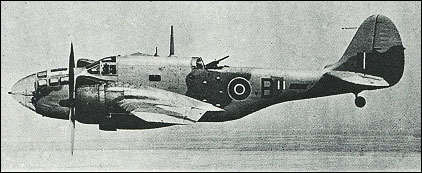|
| Whereas the Martin Maryland had been designed to meet a US Army Air Corps specification, the Martin 187 was developed from the Maryland to specific British requirements. It differed primarily by having more powerful engines and a deeper fuselage to allow direct communication between crew members; however, like aircraft such as the Maryland, Douglas Boston and Handley Page Hampden, its narrow-section fuselage made it virtually impossible for injured crew members to change positions in flight. An order of 400 of these aircraft, named Baltimaore by the RAF, was placed in May 1940, and following introduction of the US Lend-Lease Act two batches, of 575 and 600, were ordered in June and July 1941 respectively, and the full total of 1,575 aircraft was duly produced for the RAF. It should be noted, however, that this full total was not received, for some Mk III and Mk IIIA aircraft were lost during transatlantic delivery when two cargo ships carrying them were sunk. Initial deliveries of Baltimore Mk Is were made in late 1941, being issued first to Operational Training Units, and were followed by deliveries of Mk IIs in 1942 to Nos 55 and 223 Squadrons operating in the Middle East. All Baltimores were used operationally entirely in the Mediterranean theatre, proving to be effective day and night bombers. In addition to those used by the RAF, Baltimores were allocated by the RAF for service with the Royal Australian Air Force, Free French Air Force, Greek No. 13 (Hellenic) Squadron, Italian Co-Belligerent Air Force, and the South African, and Turkish air forces.

| MODEL | Baltimore Mk IV |
| ENGINE | 2 x Wright R-2600-10 Cyclone 14 radial piston engines, 1238kW |
| WEIGHTS |
| Take-off weight | 10251 kg | 22600 lb |
| Empty weight | 7013 kg | 15461 lb |
| DIMENSIONS |
| Wingspan | 18.69 m | 61 ft 4 in |
| Length | 14.8 m | 49 ft 7 in |
| Height | 5.41 m | 18 ft 9 in |
| Wing area | 50.03 m2 | 538.52 sq ft |
| PERFORMANCE |
| Max. speed | 491 km/h | 305 mph |
| Ceiling | 7100 m | 23300 ft |
| Range | 1741 km | 1082 miles |
 | A three-view drawing (1442 x 996) |
| Kristin High, e-mail, 17.07.2024 01:29 The Maryland was generally provided with x4 .303" Colt-Browning Mk.II Rifle-Calibre Machine-Guns (RCMG, sometimes LMG) in fixed, forward-firing mounts in the outer wing panels (2x2), another x4 .303 C /B Mk.II RCMG in fixed, rearward-firing mounts in the aft fuselage panels (2x2), and 3x .303" Vickers 'K' RCMG on flexible mounts for defence.
The rearward-firing guns proved utterly useless---crews generally referred to them "scare guns", after weapons employed in fields in England and the border counties to drive off birds and other scavangers. Generally, they were simply removed. The Baltimore (as with the Maryland) did not have sufficient room to mount them forward.
The original dorsal position was a typical semi-enclosed flexible mount, but this was replaced in the Mk.II with a manually-driven turret, usually with two Vickers 'K' gas-operated, drum-fed, .303" RCMG. From the Mk.III, the manual turret was replaced with a power-driven four-gun turret fitted with .303" Colt-Browning Mk.II RCMGs, the ventral position retaining its single 'K'. Late model Baltimores were supplied with American Colt Browning AN /M2 .50" Heavy Machine-Guns (HMG) in dorsal and ventral positions, and some had the same weapon in the wing panels; no Baltimore fitted with AN /M2 .50" weapons carried "scare guns", and some carried only two wing weapons.
The RAF generally did not employ the ball-mount nose-guns found in German and American bombers; fitting either a manual or power turret, fixed forward-firing weapons, or none. The Baltimore followed that practice. Lease-Lend machines, like the Mitchell or the Marauder, tended to have the weapon as-supplied, but it was generally discarded on operations.
Manually-operated flexible weapons were uniformly ineffective in WWII, and in particular, most attempts to provide ventral defence by provision of Manually-operated flexible weapons were simply discarded on operations; this, too, was generally true of the Baltimore.
Recall that bombs and fuel were the critical load, so discarding 1,000 lbs. worth of marginally-effective weaponry for more range with the same bombload, or more bombs for the same range, was operationally sound.
KAH reply | | Jim Schaefer, e-mail, 03.02.2018 21:43 what were the armenets on this aircraft? I see only one top side MG, nothing on the bottom. Any MG up front in the nose? I enjoy learning about the other aircrafts from WWII other then the famous one like the 17, 24, 25,26, and so forth. reply | | Klaatu, e-mail, 10.07.2011 18:11 Although the Maryland was issued the designation "A-30" by the USAAF, none were ever issued to, or used by, American forces. Nevertheless, they were widely used by the RAF in the Mediterranean and Italian campaigns, and were quite successful. reply | | Ricardo A. Franco, e-mail, 15.07.2009 23:01 Estoy construyendo un modelo a escala 1 /72 de la firma Nova de origen USSR de detalles muy escasos. Intento detallar el cockpit, el compartimento del navegante /bombardeo, la barquilla de bombas. Necesito acceder a fotografias del interior del avión, para poder reproducirlo
Gracias reply |
|
Do you have any comments?
|
| 
COMPANY
PROFILE
All the World's Rotorcraft
|








